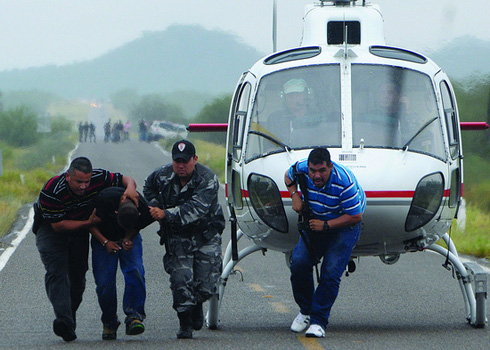
The daily bloodshed on the United States’ doorstep is the clearest sign that something is rotten in the neighborhood. Headless torsos swinging from lampposts in Ciudad Juárez in Mexico contrast all too sharply with the clean streets of El Paso just across the border, ranked one of the safest city’s in the United States. But Mexico is not alone in experiencing alarming rates of violence. Taken together, the Americas are home to 14 percent of the world’s population, but more than 31 percent of its homicides according to the United Nations Office on Drugs and Crime (UNODC).
A ruthless epidemic of violence is afflicting many states and cities in Central and South America and the Caribbean. The region’s homicide rate is more than double the global average. And in contrast to other parts of the world, whether North America, Western Europe, Africa, or Asia, the patient is getting sicker. Six of the top ten most violent countries in the world are in Latin America and the Caribbean, with most of the victims consisting of young men under 30-years of age. Violence against women is also intensifying. And for youth living in low-income settings, there is a 1 in 50 chance that they will be killed before they reach their 31st birthday.
The sad fact is that homicidal violence is just the bloody tip of the iceberg. Mexicans, Guatemalans, Colombians, and Jamaicans are fleeing violence-plagued communities in greater numbers than ever before. Literally hundreds of thousands of people have been displaced by an explosion of cartel violence in northern Mexico, and the middle class are quietly packing their bags from Caracas to San Salvador. Just as worrying, after a period of decline, rates of kidnapping and other forms of extortion are increasing in some countries. All of this stands in contrast to the region’s impressive economic growth over the past decade. But in spite of heated rhetoric to “fight” crime with more police and prisons, the violence seems to be worsening.
Not surprisingly, Latin Americans and Caribbeans are resorting to private measures to protect themselves. The private security business is booming, worth between $100 and $165 billion a year. The region’s private security personnel today outnumber police officers by almost two to one. By way of example, there are roughly 470,000 registered private guards in Brazil and another 450,000 in Mexico. And while the region’s elite are able to afford more armed guards and higher gates, the poor resort to self-defense groups and gangs. Vigilante justice is becoming increasingly common across northern Mexico and in other countries in South America and the Caribbean in the wake of police inaction.
There is no single factor that can adequately explain Latin America and the Caribbean’s surge in violence. There are, however, a host of recurring risk factors that are known to correlate strongly with insecurity. In contrast to popular belief, poverty is not strongly associated with violence. Rather, social and economic inequality and exclusion, youth unemployment, rapid and unregulated urbanization, weak police and justice institutions, and the widespread availability of alcohol, drugs, and firearms are more tightly associated with lethal outcomes. These factors, coupled with a misguided war on drugs and the deportation of former convicts from the United States, are the real culprits.
Over the past decade, so-called mano dura (heavy fist) approaches—combining forceful policing, stiffer penalties, and fast-track incarceration—were adopted by some governments to counter violence. But rather than preventing victimization, they instead ratcheted it up and filled already overcrowded prisons to bursting point. These “crime colleges” have also unintentionally deepened networks of gang members rather than contributing to their rehabilitation.
More positively, a new generation of enlightened public and private leaders is calling for renewed investment in citizen security. Sometimes with modest support from international agencies such as the Inter-American Development Bank and the United Nations, metropolitan settings like Bogota, Rio de Janeiro, and San Salvador are making progress in reversing violence and promoting social cohesion.
When courageous and legitimate political leadership is demonstrated, citizens are also more likely to take a proactive role in promoting safety and security. Nongovernmental organizations, civic action groups, private companies, and universities across Latin America and the Caribbean are emphatically saying no to violence. Social movements such as Yo Soy 132 in Mexico and Twitter and Facebook campaigns are making these voices heard, as they demand more accountability and inclusive public security. These efforts need to be supported, including by the United Nations and others in the international community. One obvious way to advance the agenda is to make citizen security and violence reduction a core foundation of the post-2015 development agenda. Put succinctly, freedom from violence is central to, and not a byproduct of, human development.
Robert Muggah is the Research Director of the Igarapé Institute in Rio de Janeiro. Sam Doe is affiliated with the United Nations Development Program in New York.
This is a cross-post from the Global Observatory. A version of this article was published in Spanish on El Huffington Post.
For additional reading on this topic please see:
Tackling Socio-Political Fragility in the Caribbean
Transnational Organized Crime, Terrorism, and Criminalized States in Latin America
National and International Dimensions of Criminal Violence in Latin America
For more information on issues and events that shape our world please visit the ISN’s featured editorial content and Security Watch.

